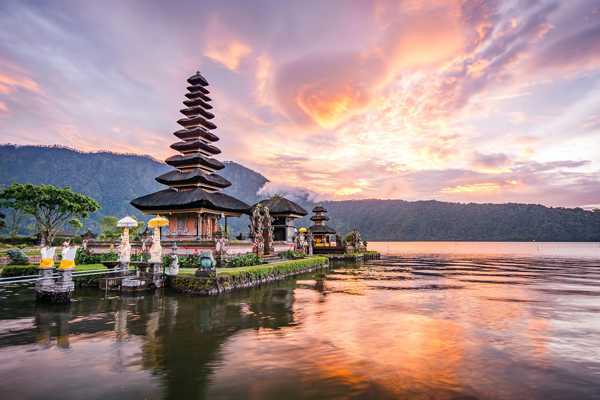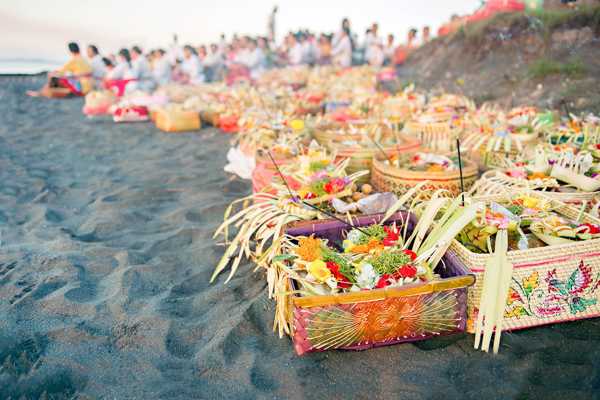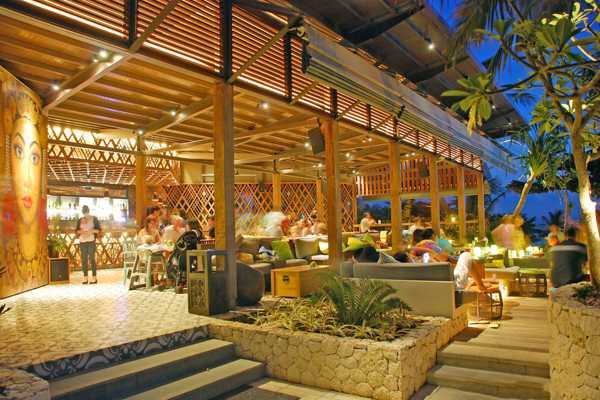Bali has a wealth of unusual sights and events that you’ll encounter on your first or even next visit to this culturally-rich island. It’s this vibrant culture that’s responsible for the island’s uniqueness, which is deeply rooted in the main religion known as ‘Balinese Hinduism’.
Besides rituals and ceremonies that take place almost daily – from the smallest households to the many majestic temples around – you can witness the many different aspects of the culture through objects and items, some so ubiquitous that they’re found almost wherever you look. These will surely draw your curiosity, so here we try to explain the most unusual things you’ll likely see in Bali.
- 1
Offerings – anywhere, anytime!

- Unusual
Balinese Hindus make offerings daily, as a gesture of gratitude and blessing. In the mornings, members of the household place small pinches of rice and the morning’s cooking on square-cut banana leaves – even if it’s just a tiny bit of salad and meat – at temple shrines for higher deities and on the ground and at crossroads for ‘lower’ spirits.
Most of the time, these small food offerings are accompanied by colourful canang flower offerings. These stitch-woven young coconut leaf trays are filled with flowers of different colours. Each is sprinkled with holy water and accompanied by a burning incense stick. You’ll come across these canang and incense placed by seaside café owners on their beachfront, so watch your step!
- 2
Penjor bamboo poles

- Unusual
Galungan and Kuningan are among the island’s most festive days when almost all streets in Bali are lined with penjor bamboo poles decorated with young coconut leaf ornaments. Naturally curved at the top, these towering bamboo poles feature significant harvest items of agrarian Bali, such as rice stalks, fruits, coconuts and coconut leaves – much like the traditional Christmas tree.
With every household voluntarily erecting a penjor in front of their houses and by the roadsides, the result is a long dreamlike archway. Besides being a gesture of gratitude towards nature for the ‘fruits of the earth’, a penjor at the time of Galungan also symbolises the triumph of good (dharma) over evil (adharma).
photo by Roland (CC BY-SA 2.0) modified
- 3
Chequered cloths

- Unusual
Black-and-white cloths drape around the trunks of large roadside trees, statues and even art performers and temple officials – it’s one of the ubiquitous colour schemes on the island. Referred to locally as saput poleng, the colour combination symbolises the harmonious balance between 2 of the most omnipresent and eternal opposites.
Harmony and balance are highly regarded and good is just as naturally occurring as bad. When you see a statue, stone or large tree draped in this cloth, they’re most likely deemed to have a life force or deity. Locals would show respect, in some way, when they pass these sites, such as honking their horns at the crossroads where a tree in poleng stands.
- 4
Elaborate coffins and festive funerals

- Unusual
Cremations are truly memorable occasions in Bali – referred to locally as either ngaben or pelebon. They’re usually loud and festive sights complete with processions and blaring rhythmic gamelan accompaniment on the way to the pyre. The coffins are also sights to behold, being ornate, towering high and carried by a troupe of male villagers. The forms and height of the coffins, or bade in Balinese, depends on the social class of the deceased.
Members of royal families tend to have higher pagoda-like coffins (measuring up to 10 metres high) meticulously constructed by the village craftsmen and decorated with flowers, masks and colourful ornaments. They can become spectacles of epic proportions, with visitors flying in just to see the rare sight.
- 5
Flying giants

- Unusual
The windy season in Bali is when the blue skies are speckled with soaring giants, locally known as layangan or layang-layang. It’s when the Bali Kite Festival starts gearing up, with dates confirmed at the last minute due to the patient wait for the most favourable weather. If you happen to be in Bali during this time of the year, the kites flown by just about every kid and village troupe offer a show for free with their gigantic creations.
Transporting massive flying works of art by truck, kite teams often require escorts to get them through the already jam-packed traffic. Successful take-offs are dramatic, complete with gamelan accompaniments to hype up spirits.
- 6
Parading giants

- Unusual
Nothing really happens on the actual Saka New Year celebration as the whole island literally shuts down for one whole day. The celebrations the day before are filled with noisy firecrackers, torches and parading monstrous papier-mâché figures around village streets. These effigies are called ogoh-ogoh and their forms get more creative, sophisticated and stunning each year.
Communal halls and roadsides become showcases of ogoh-ogoh in various forms and sizes, built through the weeks leading up to the Saka New Year Eve. Youth groups brainstorm, raise funds, conceptualise and build their mythical figures from scratch using intricately woven bamboo frameworks, adding several layers of artwork to create their most impressive creations to date.
- 7
Splashes and smooches!

- Unusual
The day after Nyepi (Saka New Year), one of the most peculiar Bali festivals takes place. On one of the roads in the village of Sesetan in south Denpasar, the whole community descends to cheer on participating youths who get in line for omed-omedan – roughly translated as ‘pull and tugs’, or even loosely, the ‘festival of smooches’.
The village festival is a localised event, undertaken only by youths of the Banjar Kaja community of the Sesetan village. As boys get in one line and girls in another, elders armed with buckets and hoses douse them with water, and a tug-of-war-like scene ensues. The scene gets crazier as the participants and asphalt become drenched with the elders seemingly enjoying their role.
- 8
Ancient blood sports

- Unusual
The male youths of the Tenganan village, several kilometres north of Candidasa, take to a raised platform arena for a coming-of-age ceremony around June or July each year. They engage in friendly bouts using tied bundles of thorny pandan leaves as weapons and woven rattan shields that interestingly don’t seem to get used that often.
The result? Garish slashed backs of manly gladiators who show no sign of pain. These friendly (if bloody) matches, known as perang pandan or ‘pandan battles’, take place during the 5th full moon on the indigenous Tenganan calendar, and are held over several days each year.
- 9
The Balinese alphabet

- Unusual
Temple plaques and signs and some road signs in Bali are subtitled with Balinese script known as the Aksara Bali or Anacaraka. The alphabet originates from the Brahmi script, which has much in common with the variety of scripts that you’ll encounter throughout Southeast Asia. Bali’s own is quite elaborate and prevails in religious texts, especially in the well-preserved ancient lontar palm leaf manuscripts.
To save the heritage script from waning, movements have called out for its preservation, and the provincial government requires all public signs to feature the script, hence the subtitles on public signs. Go ahead and ask a Balinese you meet to help you read out the signs and decipher them for you. It can be fun!
- 10
Balinese fashion

- Unusual
Traditional Balinese attire is unique and colourful. The male costume consists of a headdress known as an udeng or destar, originally folded from a single piece of square batik cloth. The batik sarongs, or kamen, are open-ended and wrapped around the waist to form a pleated front called a kancut. An outer saput wrap completes the lower male garment. Safari-style shirts are common.
For the ladies, headgear only comes in the form of optional faux-silver or golden flower hairpins worn in their bun-tied hair called sanggul. Embroidered long-sleeved kebaya come in all sorts of patterns, colours and styles; all tight-fitting, enhancing the feminine figure. Whenever you come across a procession or a ceremony, enjoy the unique fashion parade!



















